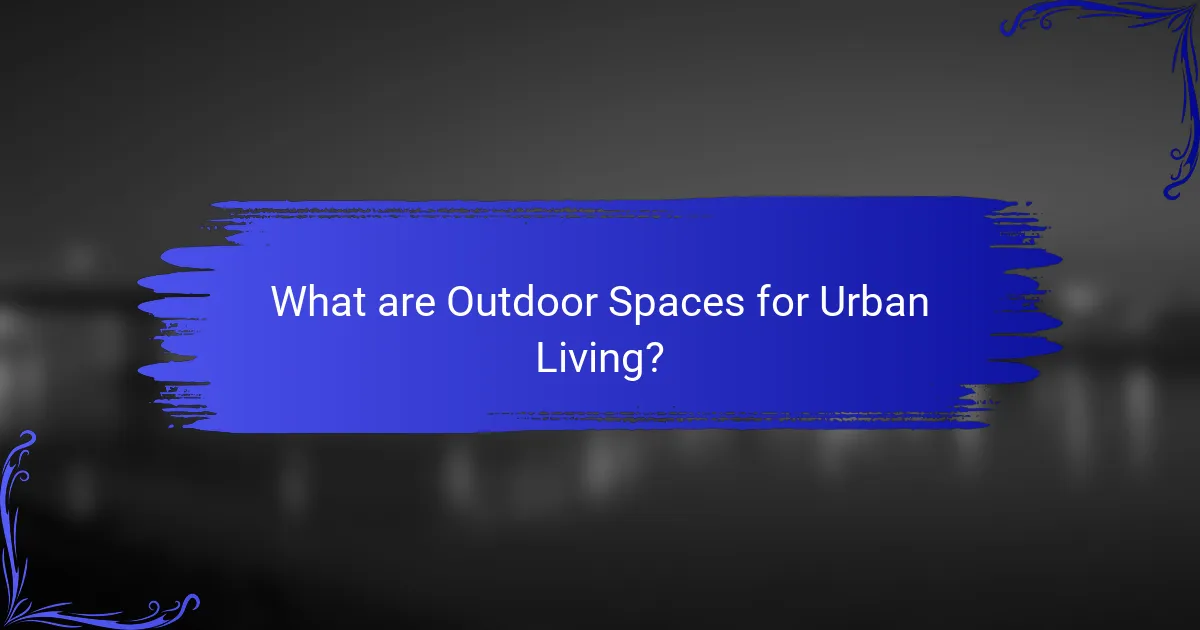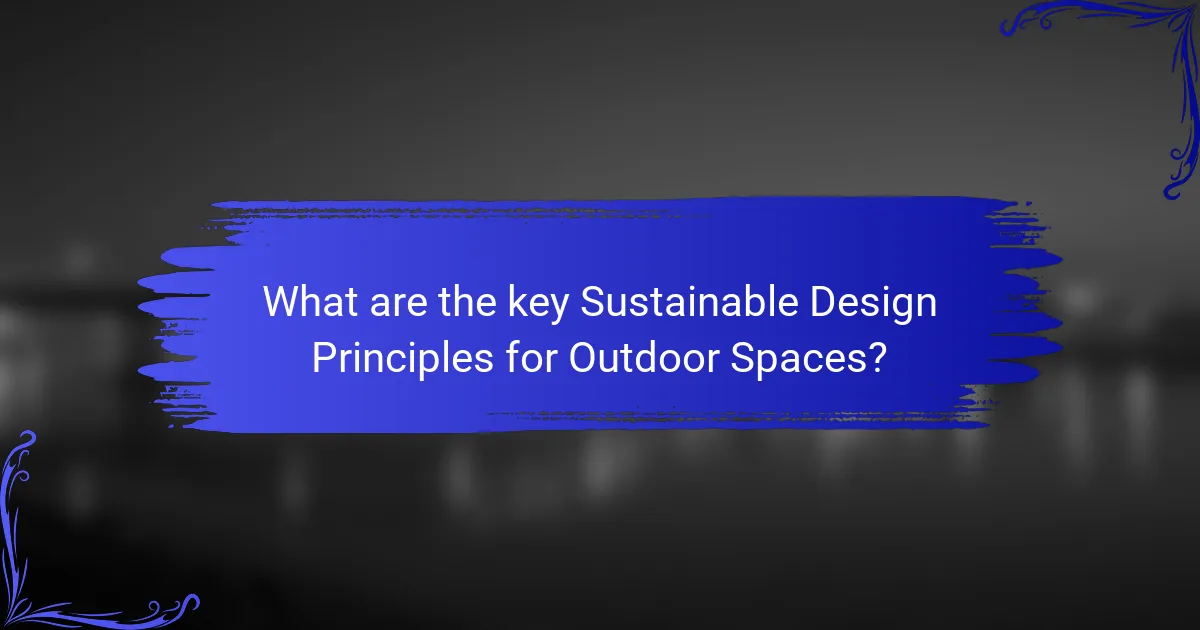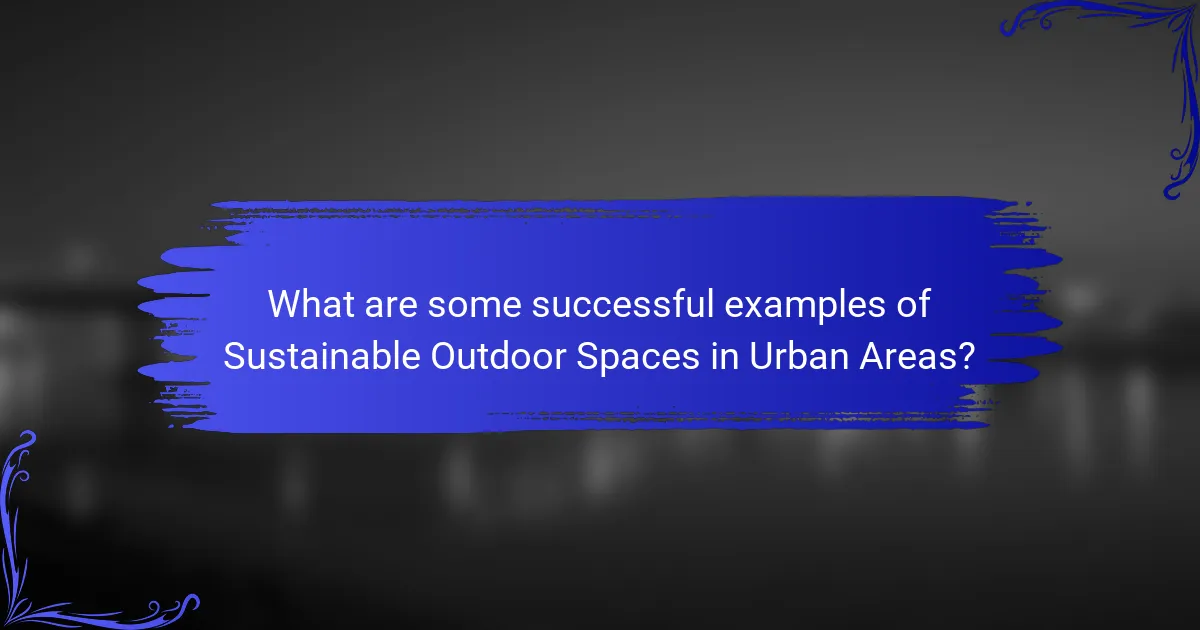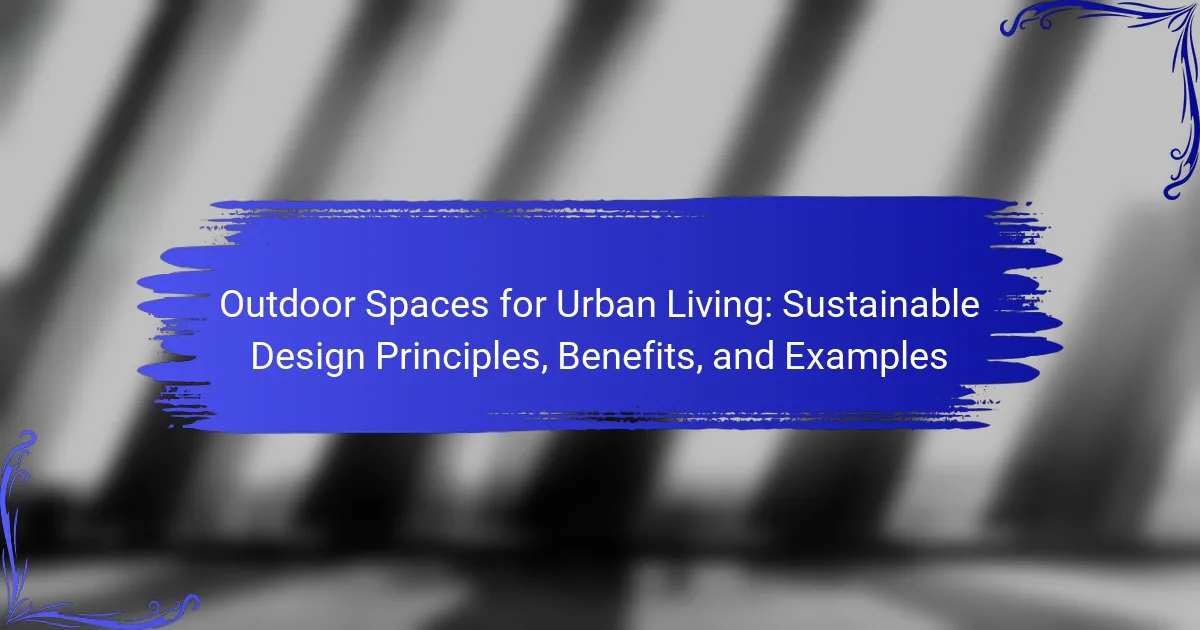Outdoor spaces for urban living are designated areas within cities that facilitate recreational and social activities, including parks, gardens, and plazas. These spaces are essential for promoting physical health, mental well-being, and community interaction, while also enhancing property values and attracting tourism. The article explores key sustainable design principles such as ecological integrity, resource efficiency, and social equity, which are critical for creating inclusive and environmentally beneficial outdoor environments. Successful examples like the High Line in New York City and Bosco Verticale in Milan illustrate how urban areas can integrate sustainability with community engagement and ecological health. Overall, the discussion emphasizes the importance of outdoor spaces in fostering vibrant, sustainable urban communities.

What are Outdoor Spaces for Urban Living?
Outdoor spaces for urban living are designated areas within cities designed for recreational and social activities. These spaces include parks, gardens, plazas, and community green spaces. They serve as vital components of urban environments, promoting physical health and mental well-being. Research shows that access to green spaces can reduce stress and enhance quality of life. Urban outdoor spaces also encourage community interaction and social cohesion. Studies indicate that well-designed outdoor areas can increase property values and attract tourism. These spaces often incorporate sustainable design principles, such as native plantings and permeable surfaces, to enhance environmental benefits. In summary, outdoor spaces in urban settings are essential for fostering community, health, and sustainability.
How do Outdoor Spaces enhance urban living?
Outdoor spaces enhance urban living by improving mental and physical well-being. Access to parks and green areas encourages physical activity, which can reduce obesity rates. Studies show that urban greenery lowers stress levels and promotes mental health. Outdoor spaces also foster social interactions, strengthening community ties. They provide venues for recreational activities, enhancing quality of life. Additionally, well-designed outdoor areas can increase property values by up to 20%. Urban greenery helps in reducing air pollution, contributing to a healthier environment.
What types of outdoor spaces are commonly found in urban areas?
Urban areas commonly feature parks, plazas, gardens, and greenways. Parks provide recreational spaces with facilities for sports and leisure activities. Plazas serve as public gathering spots for events and social interactions. Gardens, including community and botanical gardens, enhance biodiversity and offer green relief. Greenways are linear parks that connect neighborhoods and promote walking and cycling. These outdoor spaces contribute to urban sustainability and improve residents’ quality of life. According to the National Recreation and Park Association, access to parks is linked to improved mental and physical health.
How do these spaces contribute to community well-being?
Outdoor spaces contribute to community well-being by providing areas for recreation and social interaction. These spaces encourage physical activity, which is linked to improved health outcomes. Access to green spaces has been shown to reduce stress and enhance mental health. Studies indicate that communities with parks experience lower crime rates and increased social cohesion. Furthermore, well-designed outdoor environments promote biodiversity, which supports ecological health. Research by the National Recreation and Park Association highlights that people living near parks report higher levels of life satisfaction. Overall, outdoor spaces play a crucial role in fostering a sense of community and enhancing quality of life.
Why is Sustainable Design important for Outdoor Spaces?
Sustainable design is important for outdoor spaces because it promotes environmental health and resource efficiency. It minimizes waste and reduces the carbon footprint of outdoor areas. Sustainable design also enhances biodiversity by creating habitats for various species. This approach improves the quality of life for urban residents by providing green spaces that support mental and physical well-being. Studies show that access to well-designed outdoor areas can reduce stress and improve community cohesion. Furthermore, sustainable design often incorporates native plants, which require less water and maintenance. This leads to lower costs and a more resilient ecosystem. Overall, sustainable design is essential for creating functional, enjoyable, and environmentally friendly outdoor spaces.
What principles define sustainable design in outdoor spaces?
Sustainable design in outdoor spaces is defined by principles that prioritize environmental stewardship, social equity, and economic viability. Key principles include the use of native plants to conserve water and promote biodiversity. Designing for energy efficiency reduces resource consumption and greenhouse gas emissions. Incorporating renewable materials minimizes environmental impact and supports local economies. Creating accessible spaces ensures inclusivity for all community members. Implementing effective stormwater management protects water quality and reduces flooding risks. Integrating multifunctional spaces enhances usability and maximizes land use. These principles collectively foster resilience and sustainability in urban environments, contributing to healthier ecosystems and communities.
How does sustainable design impact environmental conservation?
Sustainable design significantly impacts environmental conservation by promoting resource efficiency and reducing waste. It emphasizes the use of renewable materials and energy sources. This design approach minimizes the carbon footprint of buildings and urban spaces. For instance, structures designed with green roofs can reduce heat absorption and improve air quality. According to the U.S. Green Building Council, buildings account for 39% of carbon emissions in the U.S. Sustainable design practices can lower these emissions substantially. Additionally, sustainable landscaping techniques enhance biodiversity and restore ecosystems. Implementing rain gardens and permeable pavements can manage stormwater effectively. Thus, sustainable design not only conserves resources but actively contributes to ecological health.
What benefits do Outdoor Spaces provide to urban residents?
Outdoor spaces provide numerous benefits to urban residents. They enhance mental well-being by offering areas for relaxation and recreation. Access to green spaces encourages physical activity, which contributes to overall health. Urban parks can improve air quality by filtering pollutants and providing oxygen. Social interactions are facilitated in these spaces, fostering community connections. Biodiversity is supported as outdoor areas serve as habitats for various species. Studies show that proximity to parks can increase property values. Outdoor spaces also help mitigate urban heat effects, promoting a cooler environment.
How do outdoor spaces improve mental health and well-being?
Outdoor spaces improve mental health and well-being by providing natural environments that reduce stress. Access to green spaces has been linked to lower levels of anxiety and depression. Studies show that spending time outdoors can enhance mood and emotional resilience. A 2015 study published in the journal Environmental Science & Technology found that individuals who engage with nature experience significant improvements in mental health. Natural light exposure helps regulate circadian rhythms, promoting better sleep quality. Outdoor activities encourage physical exercise, which is known to boost overall mental wellness. Social interactions in these spaces can foster a sense of community and belonging. Overall, outdoor environments support psychological well-being through various interconnected mechanisms.
What role do outdoor spaces play in promoting social interaction?
Outdoor spaces significantly enhance social interaction among individuals. They provide a communal environment where people can gather, converse, and engage in recreational activities. Research shows that well-designed parks and plazas encourage social cohesion. For instance, a study by the Project for Public Spaces found that vibrant public spaces lead to increased community connections. Features like seating areas, landscaping, and accessibility facilitate gatherings. Additionally, outdoor spaces often host events, further fostering interaction. The presence of greenery and open areas contributes to a welcoming atmosphere. Overall, outdoor spaces are essential for building relationships and enhancing community engagement.

What are the key Sustainable Design Principles for Outdoor Spaces?
Key sustainable design principles for outdoor spaces include ecological integrity, resource efficiency, and social equity. Ecological integrity focuses on preserving natural ecosystems and biodiversity. This principle promotes the use of native plants and habitats that support local wildlife. Resource efficiency emphasizes minimizing waste and using sustainable materials. For instance, rainwater harvesting systems can reduce water consumption. Social equity ensures that outdoor spaces are accessible and beneficial to all community members. This principle encourages inclusive design that meets diverse needs. These principles collectively enhance the sustainability and livability of urban outdoor environments.
How can we implement eco-friendly materials in outdoor designs?
Implementing eco-friendly materials in outdoor designs involves selecting sustainable options that minimize environmental impact. Use recycled materials such as reclaimed wood or metal for structures. Incorporate permeable paving to reduce runoff and promote groundwater recharge. Choose non-toxic paints and finishes to ensure safety for both users and wildlife. Opt for native plants in landscaping to support local ecosystems and reduce water usage. Utilize bamboo for furniture and decking, as it is a rapidly renewable resource. Consider using solar-powered lighting to enhance energy efficiency. Research indicates that using these materials can significantly lower carbon footprints in urban spaces. According to a study by the American Society of Landscape Architects, sustainable materials can reduce maintenance costs by up to 30%.
What are the benefits of using native plants in urban landscaping?
Using native plants in urban landscaping offers numerous benefits. Native plants require less water and maintenance compared to non-native species. They are better adapted to local soil and climate conditions. This adaptability leads to improved survival rates and reduced landscaping costs. Native plants also support local wildlife, including pollinators like bees and butterflies. Studies show that areas with native vegetation have higher biodiversity. They help to stabilize soil and reduce erosion. Additionally, native plants can improve air quality by filtering pollutants. Their use contributes to sustainable urban ecosystems.
How does water management contribute to sustainable outdoor spaces?
Water management significantly contributes to sustainable outdoor spaces by optimizing water use and reducing waste. Effective water management practices include rainwater harvesting and efficient irrigation systems. These methods help conserve water resources, essential in urban environments. Sustainable landscapes can utilize native plants that require less water, further enhancing sustainability. According to the EPA, implementing efficient irrigation can reduce water use by up to 50%. Additionally, proper drainage systems prevent flooding and erosion, maintaining soil health and plant vitality. Overall, water management is crucial for creating resilient and eco-friendly outdoor spaces.
What are the best practices for designing inclusive outdoor spaces?
Best practices for designing inclusive outdoor spaces include ensuring accessibility for all users. This involves creating pathways that accommodate wheelchairs and strollers. Incorporating ramps and smooth surfaces is essential. Clear signage should be visible and easy to read. Providing seating options at various heights benefits different users. Including sensory elements enhances the experience for individuals with disabilities. Diverse plant selections support various sensory experiences. Engaging community input during the design process fosters inclusivity. Research indicates that inclusive spaces improve community well-being and social interaction.
How can accessibility be integrated into outdoor space design?
Accessibility can be integrated into outdoor space design by implementing universal design principles. These principles ensure that outdoor spaces accommodate individuals of all abilities. Features such as wheelchair ramps, wide pathways, and tactile surfaces enhance mobility. Additionally, incorporating benches and rest areas supports those with limited stamina. Clear signage with braille aids navigation for visually impaired individuals. Providing accessible restrooms is also essential for inclusivity. Research indicates that inclusive designs improve overall community engagement and satisfaction. The American with Disabilities Act (ADA) sets guidelines that can be followed to achieve compliance and enhance accessibility.
What features make outdoor spaces welcoming for diverse populations?
Outdoor spaces can be welcoming for diverse populations through inclusive design features. These features include accessible pathways that accommodate individuals with mobility challenges. Additionally, seating areas should be varied in style and height to cater to different preferences.
Cultural representation in art and signage fosters a sense of belonging among various ethnic groups. Providing shaded areas encourages social interaction, especially in warmer climates. Safety measures, such as adequate lighting, enhance comfort for all users.
Community gardens offer opportunities for engagement and cultural exchange. Spaces for recreational activities support physical health and social cohesion. Research shows that inclusive outdoor environments improve mental well-being and community ties among diverse populations.

What are some successful examples of Sustainable Outdoor Spaces in Urban Areas?
Successful examples of sustainable outdoor spaces in urban areas include the High Line in New York City and the Bosco Verticale in Milan. The High Line is a transformed elevated railway that features native plants and green spaces. It promotes biodiversity and provides a habitat for urban wildlife. The Bosco Verticale consists of residential towers covered with trees and plants, improving air quality and reducing energy consumption. Another example is the Gardens by the Bay in Singapore, which integrates technology and nature through its Supertree Grove. These spaces demonstrate the potential for urban areas to incorporate sustainability while enhancing community engagement and ecological health.
How do urban parks exemplify sustainable design principles?
Urban parks exemplify sustainable design principles by promoting biodiversity and enhancing ecological health. They integrate native plants that support local wildlife. Urban parks also manage stormwater through permeable surfaces and green infrastructure. This reduces flooding and improves water quality. They provide recreational spaces that encourage community well-being and social interaction. Parks often include sustainable materials in their construction, minimizing environmental impact. Additionally, they promote active transportation by providing pathways for walking and cycling. Studies show that urban parks can reduce urban heat islands, improving local climate conditions.
What innovative features can be found in modern urban parks?
Modern urban parks often include innovative features such as green roofs, rain gardens, and smart technology. Green roofs help manage stormwater and reduce urban heat. Rain gardens filter pollutants and enhance biodiversity. Smart technology includes sensors for monitoring air quality and park usage. These technologies promote sustainability and improve user experience. Additionally, urban parks may feature multifunctional spaces for community events. They often incorporate native plant landscaping to support local ecosystems. Some parks utilize renewable energy sources for lighting and amenities. These features collectively enhance the environmental and social value of urban green spaces.
How do community gardens promote sustainability in urban settings?
Community gardens promote sustainability in urban settings by enhancing local food production and reducing carbon footprints. They provide fresh produce to communities, decreasing reliance on transported goods. This reduces greenhouse gas emissions associated with food transportation. Community gardens also improve biodiversity by creating habitats for various species. They utilize organic gardening practices, which minimize chemical use and promote soil health. These gardens foster community engagement and education about sustainable practices. Studies show that urban gardens can increase access to nutritious food, particularly in food deserts. Furthermore, they contribute to stormwater management by absorbing rainwater and reducing runoff.
What lessons can be learned from successful outdoor space projects?
Successful outdoor space projects demonstrate the importance of community involvement. Engaging local residents in the design process fosters a sense of ownership. This participation leads to spaces that meet the actual needs of the community. Successful projects often prioritize sustainability in their design. Incorporating native plants and sustainable materials reduces environmental impact. Research shows that green spaces improve mental health and well-being. Successful projects also emphasize accessibility for all users. Ensuring that outdoor spaces are inclusive enhances community use. Furthermore, ongoing maintenance is crucial for long-term success. Regular upkeep keeps spaces inviting and functional over time.
How can urban planners replicate successful outdoor space designs?
Urban planners can replicate successful outdoor space designs by analyzing existing models and adapting their principles. They should study case studies of renowned outdoor spaces, such as New York’s High Line or Paris’s Promenade Plantée. Planners must identify key design elements that contribute to user engagement and environmental sustainability. Incorporating community feedback during the design process enhances relevance and usability. Utilizing local materials can reflect the area’s identity and promote sustainability. Implementing flexible spaces allows for diverse activities and events, fostering community interaction. Monitoring and evaluating the usage of these spaces helps in making informed adjustments over time. Successful outdoor spaces often prioritize accessibility, ensuring that all community members can enjoy them.
What are common challenges faced in implementing sustainable outdoor spaces?
Common challenges faced in implementing sustainable outdoor spaces include limited funding and resources. Many projects struggle to secure the necessary financial support for sustainable practices. Additionally, there is often a lack of community engagement in the planning process. This can lead to spaces that do not meet the needs of local residents.
Another challenge is the complexity of integrating sustainable technologies. These technologies can be expensive and require specialized knowledge for effective implementation. Furthermore, regulatory hurdles can impede progress. Local zoning laws may not support innovative sustainable designs.
Lastly, maintaining these spaces poses ongoing challenges. Sustainable outdoor spaces require continuous care and management to thrive. Without proper maintenance, these areas may fail to deliver their intended benefits.
What practical tips can enhance outdoor space design in urban environments?
Incorporating greenery enhances outdoor space design in urban environments. Plants improve air quality and provide shade. Use vertical gardens to maximize limited space. Integrate seating areas to encourage social interaction. Ensure pathways are accessible for all users. Utilize sustainable materials for durability and environmental benefits. Implement water features for aesthetic appeal and sound masking. Create designated zones for activities to cater to diverse community needs.
Outdoor spaces for urban living encompass parks, gardens, plazas, and community green spaces that are essential for promoting physical health, mental well-being, and social cohesion in urban environments. This article explores the sustainable design principles that enhance these spaces, detailing their benefits such as improved mental health, increased property values, and environmental conservation. It also highlights various types of outdoor spaces, the role of sustainable materials, and best practices for inclusivity and accessibility. Successful examples of urban outdoor spaces demonstrate the effectiveness of these principles in fostering community engagement and ecological health.
